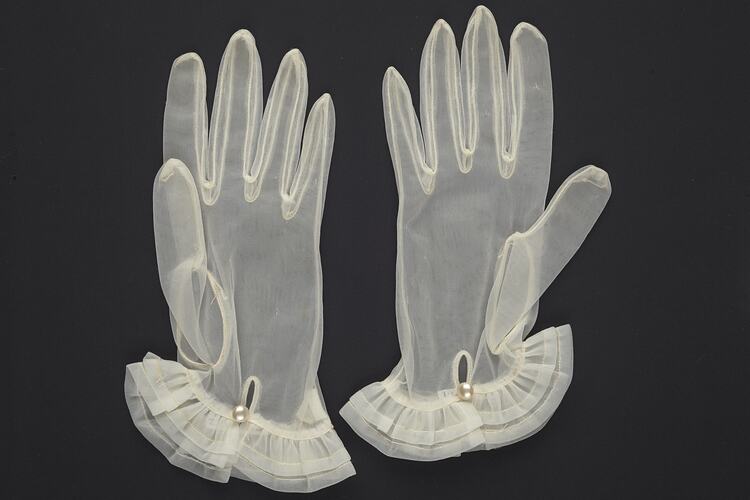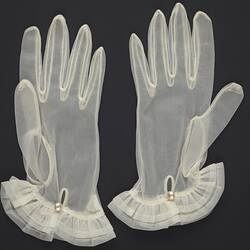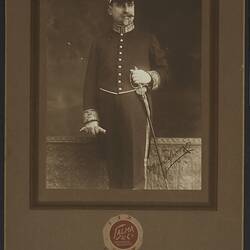Summary
Pair of white, net gloves with frill wrist trim, worn by Antigoni Kyriazopoulos in Melbourne, circa 1920s. Antigoni Dimissa migrated to Australia from Greece in 1909 to marry Constantine Kyriazopoulos, a doctor who had arrived in Melbourne in 1902. They were from a similar part of Greece and knew each other before migrating. Antigoni, a well educated woman, became active in Melbourne's cultural, social and fund-raising life.
Physical Description
Fine white net wrist-length gloves with frill at each wrist. Wrist secured by pearl button.
Significance
This collection holds enormous social and cultural significance for the state collection. Its value lies in its breadth of material (textiles, documents, tools and equipment, and photographs) and strength of its provenance. The story and the objects which belonged to Dr Constantine and Antigoni Kyriazopoulos enable the museum to both represent and explore key themes, including early 20th century, non-British migration; professional rather than the more common labour and trades category of male migration; early 20th century social and cultural life in Melbourne; female agency is creating migrant support networks; examples of individual discrimination in early 20th century Australia; and the maintenance and adaptation of a cultural identity through the process of migration and settlement.
The documents relate to the doctor's working life (business cards, letterhead and invoice, medical congress identity tag, professional qualifications certificate and diploma), his ongoing connections to Greek cultural life (Greek play booklets and periodicals), his position as Greek Consul (Victorian Government gazette announcement and Consul letterhead) and his decision to change his surname (deed poll), a common migrant experience. There is also a rare passport belonging to Antigoni demonstrating her return passage to Melbourne.
The clothing items, particularly the Greek consul uniform is an excellent example of active and visible cultural maintenance, as well as official recognition. The women's clothes and accessories (dresses, jackets, gloves, bags, belts) are significant as strong examples of their period, and as examples of clothing (procured both in Melbourne and in Greece) worn by affluent women of non-Anglo background in Melbourne in the 1910s and 20s. The collection of underclothes augment the museum growing collection of women's trousseaux which ranges across time and culture.
The medical case, brass plaque and medical tools offer tangible evidence of the doctor's professional tools of trade from this early period while the uniform and flags enable the representation of Consul activity in early 20th century Melbourne,
More Information
-
Collecting Areas
-
Acquisition Information
Cultural Gifts Donation from Mrs Fife Denovan, 14 Mar 2012
-
Original Owner
-
Format
Photograph, Black & White
-
Classification
-
Category
-
Discipline
-
Type of item
-
Overall Dimensions
101 mm (Width), 203 mm (Height)
-
Keywords
Greek Immigration, Greek Communities, Clothing, Fashion, Gloves, Women's Clothing, Women's Clothing Accessories



